The Motorola Moto G4 and G4 Plus Review
by Brandon Chester on August 15, 2016 8:00 AM EST- Posted in
- Smartphones
- Lenovo
- Motorola
- Moto G
- Moto G4
Display Analysis
One of the standout features of the original Moto G was its display. It was a 4.5" 1280x720 display, which gave you a higher pixel density than many other smartphones at the same price which still used 960x540 displays. It certainly wasn't the best calibrated display, but for its time it was one of the best you could find in a mid-range smartphone.
Fast forward to 2016, and we now have $200 mid-range phones shipping with 1920x1080 LCD displays. Phones have also continually gotten larger, with 5.5" seemingly being the new norm for mid-range devices. The Moto G progressed from its original 4.5" display to a 5" one with the 2014 and 2015 models, and has now gotten even larger with the 5.5" display on the Moto G4. Like competing smartphones, the Moto G4 also moves to a resolution of 1920x1080. I really feel that this continued increase in size has been at the expense of usability, but I've already mentioned that in this review, and at this point consumers don't really have any smaller alternatives at this price point anyway.
While the first three models of the Moto G maintained a 720p resolution, Motorola improved the accuracy of their displays as well as other attributes like the peak brightness and black levels. With the Moto G4 moving to a 5.5" 1080p display, I'm curious to see if there have been similar improvements to attributes beyond size and sharpness. To examine the display in greater depth than what is presented on a spec sheet, I've run our standard suite of display tests. As always, measurements are performed with an X-Rite i1Pro 2 spectrophotometer, and managed using SpectraCal's CalMAN 5 software.
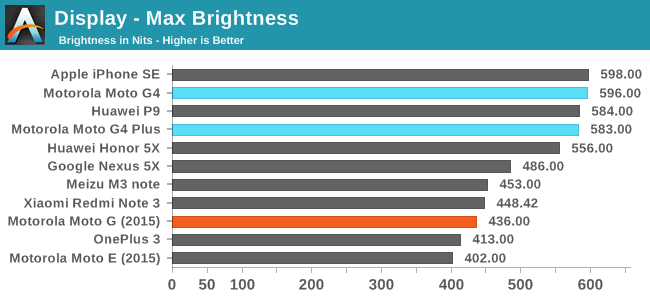
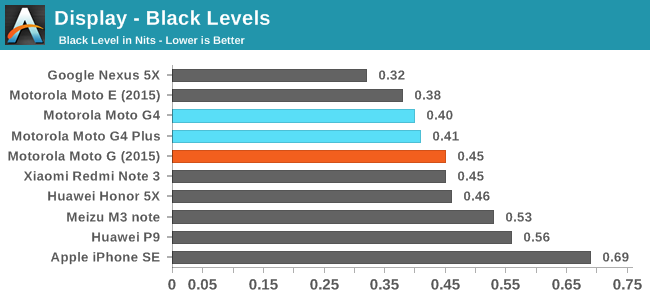
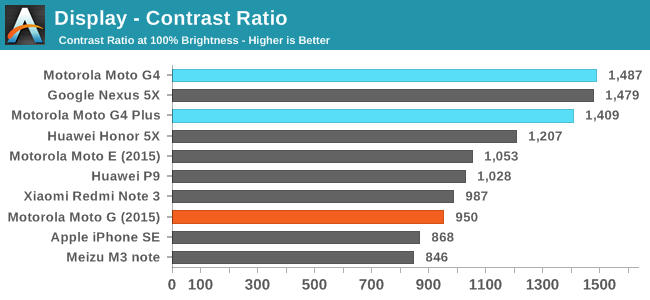
Both the Moto G4 and G4 Plus achieve a high peak brightness, as well as a relatively low black level relative to that brightness. This leads to the G4 achieving the highest contrast ratio that I've seen on a device at this price point. Among the mid-range devices that I've chosen for comparison, the Moto G4 definitely has the best display as far as brightness and contrast is concerned.
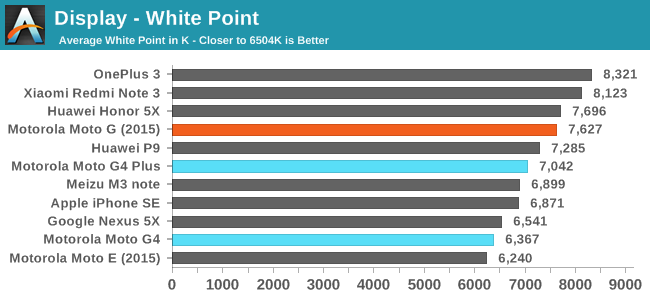
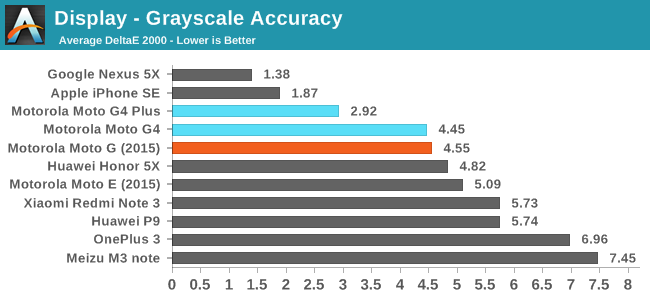
Moto G4 Plus DeltaE 2.92
Moto G4 DeltaE 4.45
Having two devices with the same LCD presents an interesting situation where the two can be compared to examine the degree of variance with the calibration. It was clear to me right after I turned on both phones that the normal Moto G4 exhibited a slight green tint and was warmer than the Moto G4 Plus, which was definitely shifted more toward blue than our target white standard of D65. In both cases gamma is a bit high, although this is more pronounced on the Moto G4 Plus. It's also clear that between these two units, the Moto G4 Plus exhibits a greater level of accuracy. For a phone that starts at $200, I would consider both results to be acceptable, but the greyscale accuracy on the G4 Plus unit is definitely a step ahead of the normal G4 unit.
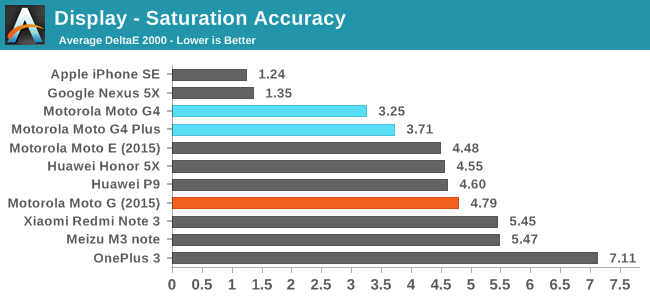
Moto G4 Plus DeltaE 3.71
Moto G4 DeltaE 3.25
The tables turn when examining saturation accuracy, as the normal Moto G4 demonstrates a slightly greater level of accuracy. The Moto G4 Plus has higher error levels with blue, cyan, and magenta due to the blue-shifted greyscale. Again, in both cases the display is more than acceptable for a $200 smartphone, but it is interesting to see what tolerances Motorola has for display variance from one unit to another.
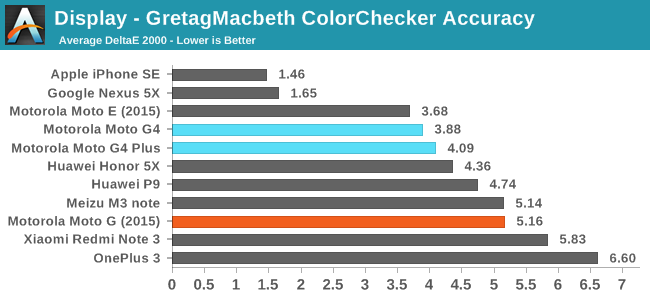
Moto G4 Plus DeltaE 4.1
Moto G4 DeltaE 3.88
Accuracy in the GretagMacbeth ColorChecker test is very similar between both Moto G4 units, but the normal G4 again has a slight advantage. This difference is mostly academic, and I would actually argue that you'd be better off with the G4 Plus because in this case the normal G4 has a critical error in the light skin shade, which is a color you're likely to come across more so than others. Ultimately both displays are very good for the price, and I don't think users are going to have any issues with the level of accuracy if it can be assumed that all Moto G4 and G4 Plus phones have similar calibration.
Drawing conclusions about displays can be a bit difficult when you have two devices to compare. On one hand, my less accurate unit could be exceptionally poor. On the other hand, my more accurate unit could be exceptionally good. I can only make concrete conclusions based on the data I've collected, and so it's probably best to evaluate based on the worst results. In this case both devices were similar enough, although the G4 Plus has the display I favor because green shifting in the greyscale is something I find much more bothersome than blue shifting, as I've gotten used to the latter due to its pervasiveness on WLED-backlit LCD displays.
The fact that both displays were relatively close in their accuracy hopefully indicates that users can expect this level of accuracy on any Moto G4 device, although I can't say that for certain. Based on the information I have, I'd say that users buying a Moto G4 should be getting a display that is exceptionally bright, with good black levels, and decent color accuracy, and I think that makes for a pretty good $200 smartphone display.


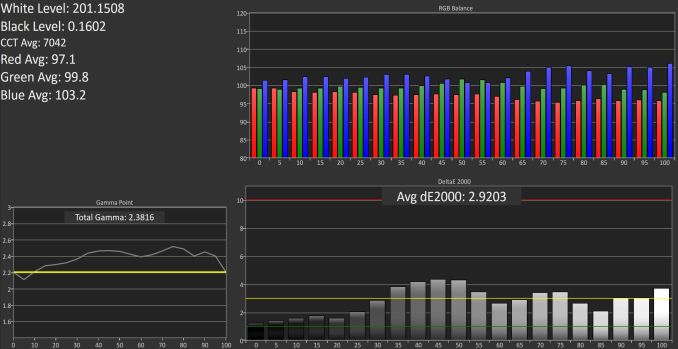

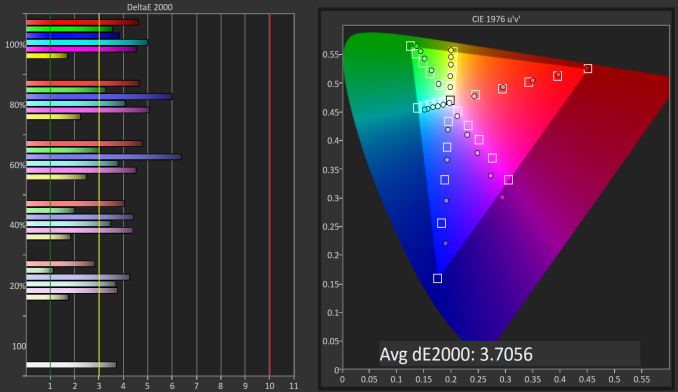

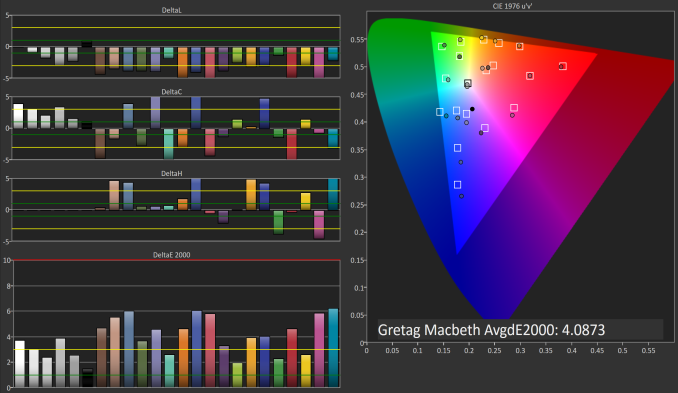
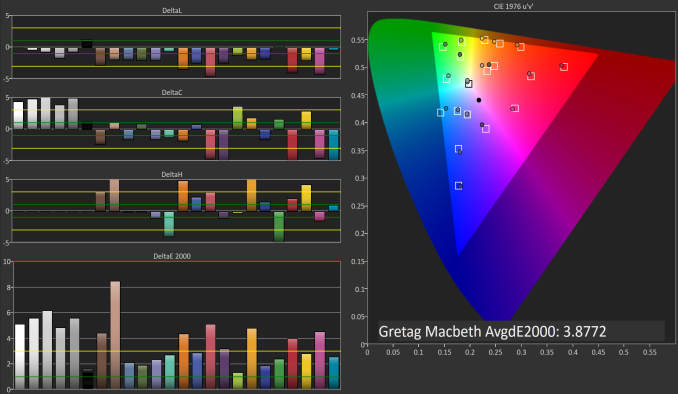








94 Comments
View All Comments
stardude82 - Tuesday, August 16, 2016 - link
Well, I picked up a Moto G4 for $125 and the Moto G4 Plus has features which the 5X doesn't have. The Nexus 5X is not that much better of a phone in my opinion and the lack of SD slot is a deal breaker for many.Cod3rror - Monday, August 15, 2016 - link
I have to say the camera on G4 Plus is very impressive in daylight pictures. I like to pixel peep and I think G4 Plus was the best out of the bunch. OP3 looks great, but if you look at the images at 100%, they look oil painted, especially the vegetation. Either the camera technology has plateau-ed or lower end devices are really upping their game in this area.Did you experience any ghost touch issues? Motorola forums are riddled with complaints about ghost touch issues with G3s and G4s.
It's disappointing to read about the jittery UI, Moto G3 is smooth (we're talking by Android standard here) and fast.
I think in general Motorola has been going downwards after Lenovo purchased them. They had issues with G3 screens with ghost touching as mentioned (build quality and design is awesome though), they clearly slacked on G4, have the same screen issues and overpriced it too (at that price, it should've been SD650).
Brandon Chester - Monday, August 15, 2016 - link
I really haven't had any issues with ghost touches or overheating or anything like that. I was playing Pokémon Go which is a relatively intensive game (partially due to terrible design) and the phone was working fine. My main issue has just been the generally poor performance.archaicertes - Tuesday, August 16, 2016 - link
I noticed ghost touch days after I bought it. Not just while charging. I returned it because they wanted us to send it in for repair and wouldn't share the solution.WPX00 - Tuesday, August 16, 2016 - link
The camera should be impressive. The OV16860 is a part meant for FLAGSHIP phones, not $250 devices. Put OIS in it and a nicer quality lens and I would be quite happy to see it on a high end LG or Nexus. OIS sometimes makes all the difference: remember the $624 Moto Z uses the same sensor as the $149 Moto G4 Amazon Edition, but with OIS and a faster lens, making it a better camera than the $249 Moto G4 Plus which in theory has a better sensor part.Sumedh - Monday, August 15, 2016 - link
I have been using g4 plus for 2 months and i would like to point out the heating problem in it ..it gets too hot while playing games and also starts lagging while charging ..and camera slows down if you use it for more than 15minssinsin - Monday, August 15, 2016 - link
One of the saddest parts is that Moto/Lenovo has put the same camera sensor (as Moto G4, Moto G 2015, Nexus 6 (2014)) on it's newest flagship Moto Z (2016).TheinsanegamerN - Monday, August 15, 2016 - link
these would be good phones if they were not made by lenovo, a company that cannot be trusted with privacy and has already confirmed they will not be providing regular updates.markiz - Monday, August 15, 2016 - link
Brandon, you mentioned a few times here that you find larger screens as having a negative impact on usability?Seeing as how I am of the opposite conviction (or have a wrong understanding of the word usability) I though it would be a good idea to explore in an article. How does smartphone screen size affect usage.
For example me, I could not care less for one handed usage, nor can i understand why would anyone care, so it would be interested to understand why.
Pissedoffyouth - Wednesday, August 17, 2016 - link
I could see on a crowded subway one handed use being popular